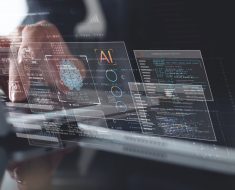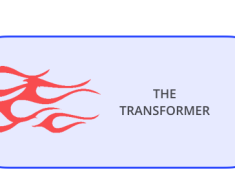
Transcription:
Transcripts are generated using a combination of speech recognition software and human transcribers, and may contain errors. Please check the corresponding audio for the authoritative record.
Penny Crosman (00:03):
Welcome to the American Banker Podcast. I’m Penny Crosman. Will all the buzz and drama around generative AI turn into tangible results and major changes to jobs in banking in 2024? We’re here today with Michael Abbott, global banking lead at Accenture, who will share some of his predictions and opinions about bank’s use of generative AI and other technologies in the coming year. Welcome, Michael.
Michael Abbott (00:29):
Thank you, penny. It’s good to be back and happy new year.
Penny Crosman (00:33):
Thanks, you too. So in a recent report from Accenture, you said that generative AI has the potential to boost bank’s productivity by about 22 to 30%. How do you think that might happen? What are some examples of operational efficiencies that banks might get through generative ai?
Michael Abbott (00:53):
Yeah, penny, it’s a great question and when you look at that 20 to 30%, what we’re referring to and you mentioned is kind of operational efficiency, right? The way that drive operational efficiency, one of the things I have learned from actually implementing a number of different generative AI efforts is in many cases banks are choosing to what I would describe as take the waste out and put value in. So for example, just to put a few things out there, we’ve seen banks and many up and down the spectrum from the largest to actually many regional and smaller banks implement generative ai, do post call recordings. So you’ll be able to listen into a phone call and at the end of the phone call, typically a call center rep will have to summarize what was the conversation with that customer. That might take four to five minutes.
(01:38):
You can now do that in a matter of a few seconds and then have the call center rep look at it to confirm what degenerative AI did was correct, but now it can drop it in. So there’s four minutes off of a call right there. We’ve seen mortgage loan origination providers starting to use it to be able to pull in a loan and then pull in a vectorized information of all the Fannie Mae requirements and then push that loan up against those requirements and quickly get at what some of the red flags would be at a much faster way than simply having to read through everything and go through individual parts of it. So those are just two simple examples, but when you take that and you apply it across all of the operational components inside of banking, you realize in the operational side you could probably get 20 to 30% efficiency, but I don’t think all of it’s going to go to the bottom line.
Penny Crosman (02:30):
Interesting. And just within that, do you see layoffs or jobs being lost because of those efficiencies?
Michael Abbott (02:42):
I get that question all the time. Will there be layoffs? I was talking to one major bank, COO, and this person summed it up pretty well for me. They said, look, what I want to do is I want to take waste out and put value in. I don’t need to get rid of any more people. I just don’t want them to waste time doing non-value added things. I want to free up their time to have conversations with my customers about cross-selling and upselling whether or not a bank takes it to the bottom line. We’ll see. But many that I talk to, they’re looking, they’re actually looking to take more of a waste out value and approach than just simply use it for an efficiency gain. Because again, if you look at cost to income ratio, there’s two parts to that cost and income. If you can take out cost that is not value added and turn it into opportunities to create more income, that’s much more valuable to the top line of a bank. And I think people are starting to understand that quite well. In fact, Patty, you just prompted me to think of something here. If you look at generative ai, one of the things we did put in a report too is that we believe that the revenue opportunity from generative ai, the upside potential far outweighs the cost side. And I think that’s critical. That’s very different than let’s say the digital revolution we just went through.
Penny Crosman (04:05):
And what are some of those revenue increasing opportunities that you see?
Michael Abbott (04:11):
Yeah, I mean we, I’ve seen banks around the world already use generative AI to develop customized safe scripts for depositors to decide exactly what rate they have to do. I mean, deposit beta is perhaps one of the hottest topics out there right now. Imagine now being able to figure out exactly, do I need to give this person the six months, 80 to 12 months, 80? What’s the rate need to be? And if you can optimize that just a few basis points, the opportunity there is enormous. So I’ve seen banks go from just having two or three or a dozen save scripts to being able to develop a thousand save scripts against the behavioral economics of that particular customer and get to the answer faster. So that’s just one example of a revenue opportunity out there.
Penny Crosman (04:54):
Well, so with all this potential for generative ai, there are risks out there. There’s obviously the potential for bias, there’s a potential for hallucination, there’s a potential for copyright infringement. How do you think that banks and other companies need to think through these risks?
Michael Abbott (05:18):
Yeah, there’s a big question here around what I would describe as responsible ai. And every bank already has a responsible AI framework. The question is how do you project that into this class of generative AI models? Which to your point, can hallucinate? What we’ve seen so far is I’ve seen, I have not seen any bank allow these models to just go directly out to the customers. They’re all using what I would describe as a human in the loop approach, meaning they’re using generative AI to augment, not automate necessarily. And that’s a really good way until we exactly all the risks with this, to be able to leverage these models in a safe way that ensures that you’re doing the right thing for the customer.
Penny Crosman (06:06):
So I guess I wrote recently about the co-pilot concept and some of the examples you were describing kind of fit in that model, I think where you’re using it as an A to create notes at the end of a call or that kind of thing. Do you see that as sort of a common use case?
Michael Abbott (06:28):
I think the copilot use case is probably going to be one of the most common ones out there. And I think of it like playing chess and having Casper whisper in your ear and telling you this is the right move to make next, right? You still have to make the move. It’s still your decision. You still have to look at that and say, is that the right thing to do? But it is nice to have somebody who really knows what they’re doing or has a second look at it to be able to tell you, you might want to look at something this way. So I do think the co-pilot approach is going to be more the norm right now than anything else.
Penny Crosman (07:03):
So I’m seeing, and I think you’ve sort of alluded to this already, that a lot of banks are taking a fairly cautious approach. They’re experimenting with large language models, they’re making these models available to staff for internal purposes like these, but they’re taking their time actually pushing this out to customers, or as you said, completely automating things. When you look at these approaches, do you think this is right? Do you think banks are moving too fast or too slow?
Michael Abbott (07:39):
I would describe it as a cautious, aggressive approach is probably the way I would describe it. And what I mean by that is they’re absolutely taking their time in terms of how this is going to impact customers and so on. But I’m also seeing banks be very aggressive in their internal adoption, their experimentation. They’re looking at the way of how you’re going to scale out these platforms, various different models that are out there, and they’re being very aggressive in terms of understanding the potential of what they can do with this, but they’re being cautious to make sure when they do put it into production that it’s going to meet all the standards and requirements they have. So it’s a cautious, aggressive approach right now, is how I would describe it.
Penny Crosman (08:22):
And what about banks that have very old core systems? Are they going to be able to do any of this? Are they going to be left behind? Are there ways to replace an old core system with generative AI eventually?
Michael Abbott (08:39):
Well, a couple of things, just stepping back at the macro level, when you look at generative ai, it’s going to impact every single part of the bank from enterprise functions like legal risk compliance to operations that we talked about with the call center to the technology stack, all the way up through to your marketing and content generation and how you’ll deal with relationship management and marketing and so on. So the important point there is, unlike digital, where you could hire a chief digital officer and he or she could develop you a mobile app or an online banking site with generative ai, it’s going to be diffused throughout the entire organization. So when you look at that, your supply chain, many parts will adopt generative AI very fast. But to your point, the digital core, the core system is the backbone of the bank. And what we’re seeing is we’re seeing generative AI actually applied on it right now.
(09:35):
And this is I think perhaps one of the most transformative ideas that I’ve seen early in the generative AI lifecycle. And it’s the ability penny to reverse engineer 30, 40 years of legacy cobalt code into, it’s almost close to its original requirements. Is it perfect? No, it’s not perfect yet sterly days, but we’re seeing 80, 85% accuracy and reverse engineering legacy code into requirements, and then using engineers to modify that and structure it a little bit better, and then you can forward engineer it back into a modern architecture. So in many ways, yes, a legacy core might be a constraint for generative ai, but generative AI is going to change that itself and make it possible to unlock the key to that core. It’s a fascinating turn of events.
Penny Crosman (10:34):
Just so I understand. So you’re letting the large language model ingest all of the code in a legacy core and reverse engineer it, and then it’s going to build a new core?
Michael Abbott (10:48):
I mean, it’s not as turnkey, right? That’s why I wanted, let be caution here. It’s not as turnkey as push a button, reverse engineer, build a new core. But yes, we’ve already been using it to reverse engineer legacy cobalt code, not all at once. You have to break it down, so it’s components and so on and so forth, but reverse engineer that legacy cobalt code into its original specifications. And then once you have those original specifications, you can modify them, modernize them, architect it the way you want, and then you can use generative AI to create the next generation of code. Now again, is it perfect? Absolutely not. It still requires people that understand what they’re doing in there and so on, but it takes an enormous amount of time out of the effort.
Penny Crosman (11:32):
It’s interesting, there are a lot of companies that make that their living taking old systems and help helping banks kind of migrate to something new. So it would be interesting to see if this is a new wrinkle on that that could be an alternative to some of those. So I know generative AI is what everybody’s still talking about all the time, but are there any other technologies that you think will be kind of important to banks in 2024? Anything they’re going to be particularly wanting to upgrade or invest in?
Michael Abbott (12:10):
Yeah, I mean, clearly the generative AI technology will be the forefront of what you’ll see people, I do think you’re going to see a cloud. I mean, cloud has been out there for a number of years now. In some of these scenarios, I’m seeing banks enter what I would describe as their third generation, believe it or not, of cloud adoption. And what I would say is, I’d say on the technology front, there’s none that are as transformative generative ai, but there are changes happening that I believe are probably just as transformational. So take cloud as an example. The first two generations of cloud adoption for most banks, banks took their on-prem processes and they projected them onto the cloud. And in many scenarios, they brought the cloud to its needs. It is very hard to stand up new environments. They had all these process controls and checkpoints, et cetera.
(13:05):
Instead of adopting a cloud first mindset, which is I’m going to engineer my controls into the cloud. And what we’re seeing right now is we’re seeing this subtle but critically important shift where banks are taking a cloud first approach and instead architecting their own systems to look more like the cloud going forward. So it’s almost an inversion of the operating model of the past. So I think that’ll be big. I also believe that a lot of, some of the data technologies that are emerging out there, especially data, the concept of a data mesh data as a product and having product owners for data will continue to be transformational. That started last year, and we’re seeing that take off in earnest this year. And again, that feeds the whole concept of generative ai. You need that data to make that all possible. And I think increasingly you’re going to hear a term of what I would describe as synthetic data, which is how do I take all the information I have and how do I amalgamate it together into a combined set of data that can feed these AI models? And so I think lot, you’ll see a lot of innovation around data in 2024 too.
Penny Crosman (14:15):
And when you see data mesh, what exactly do you mean with that?
Michael Abbott (14:22):
If you think of it in data inside of a bank as a whole host of lakes that are out there, but they don’t have streams between them, they’ll have easy ways to connect between them. A data mesh doesn’t just put a stream between it, it puts it a complete canal system that allows you to bring data from one lake to the other very easily and tie it all together in simplistic terms. So it takes what amounts to a lot of puddles of data and turns them into one coherent that you can get to and you can navigate across. In simple terms,
Penny Crosman (14:56):
I like all the water analogies. That makes sense. I mean, just playing with chatt, bt, you can see that the fact that, well, at least if you don’t buy premium, the fact that it hasn’t been updated in a while makes it pretty limited in terms of the questions that it can answer somewhat reliably for you. So it just seems like the not necessarily garbage and garbage out, but the having really UpToDate accurate data is going to be so critical to all of this.
Michael Abbott (15:29):
As you think of generative AI, and you think of that chat GBT moment that all of us have experienced, right? It’s using data that’s out there publicly available. What you have to envision is a future where you now have the bank’s information held in confidence, right? Not out there publicly, but using the same model. But with that information that can give you information, give you the insights that you see from the chat GPTs of the world, but on a private basis. And that’s the power you have to bring the data together with a model. In fact, in many cases, penny, I think a lot of people see the model and the data as being the same thing, right? But it’s not, the model is what will transverse the data and give you the information back in the way you want. The data itself is though very separate,
Penny Crosman (16:21):
But both are super important. If you want action. Exactly.
Michael Abbott (16:24):
Both are very important. And when you can take the model and combine it with the bank’s data, that’s where you get the magic.
Penny Crosman (16:28):
That makes sense. Well, Michael Abbott, thank you so much for joining us today, and to all of you, thank you for listening to the American Banker Podcast. I produced this episode with audio production by Adnan Khan. Special thanks this week to Michael Abbott at Accenture. Rate us, review us and subscribe to our content at www.americanbanker.com/subscribe. For American Banker, I’m Penny Crosman and thanks for listening.
Michael Abbott (16:54):
Thank you, penny.



